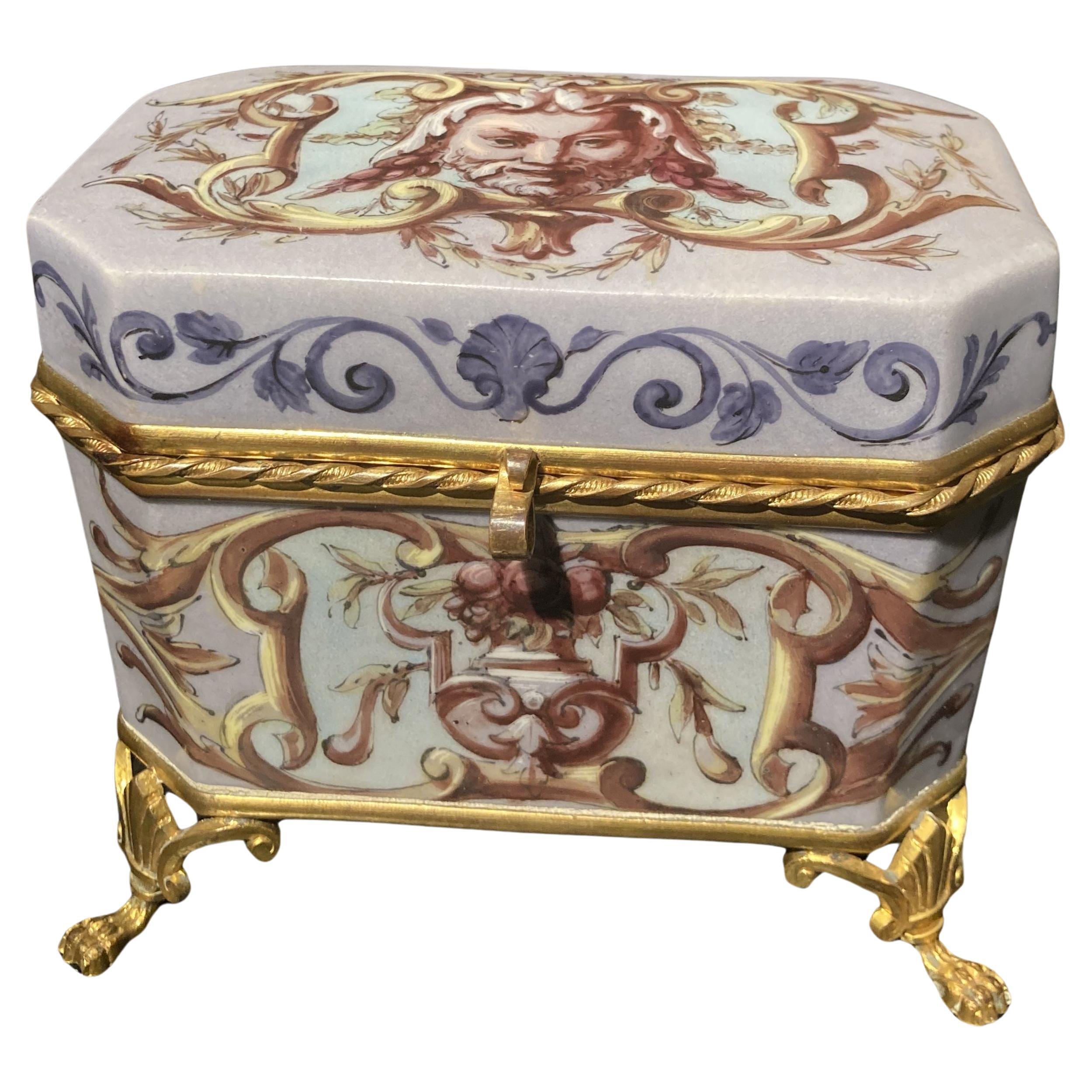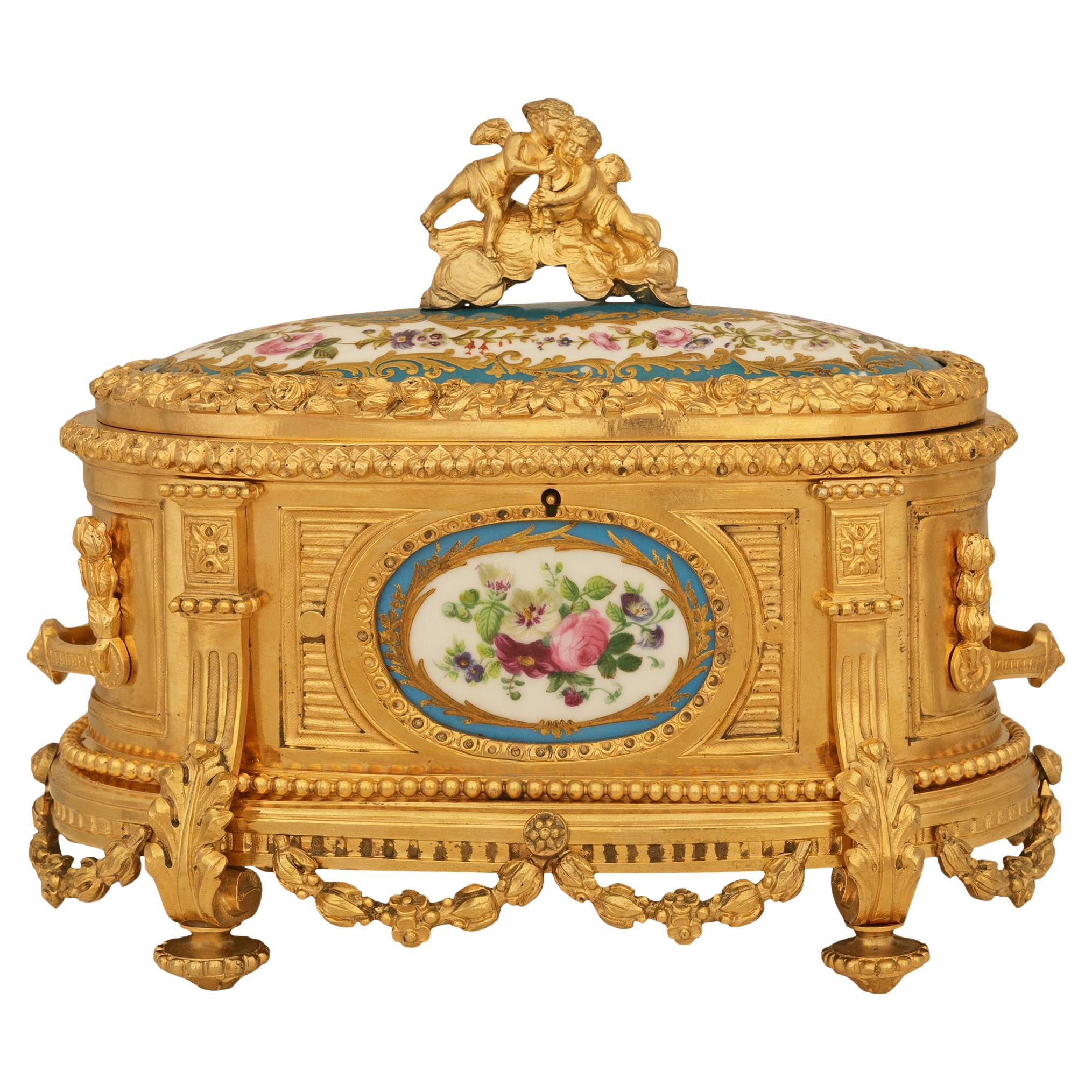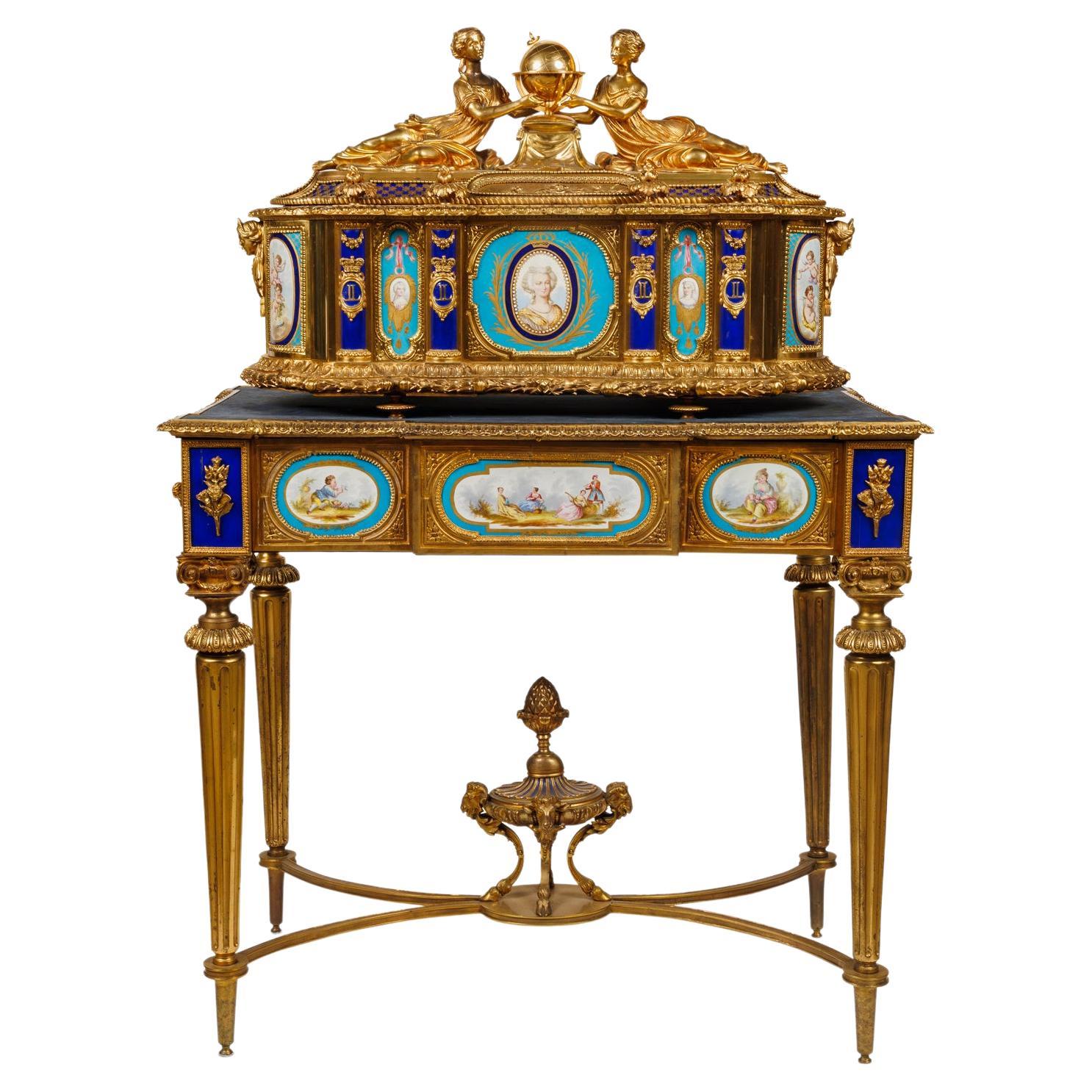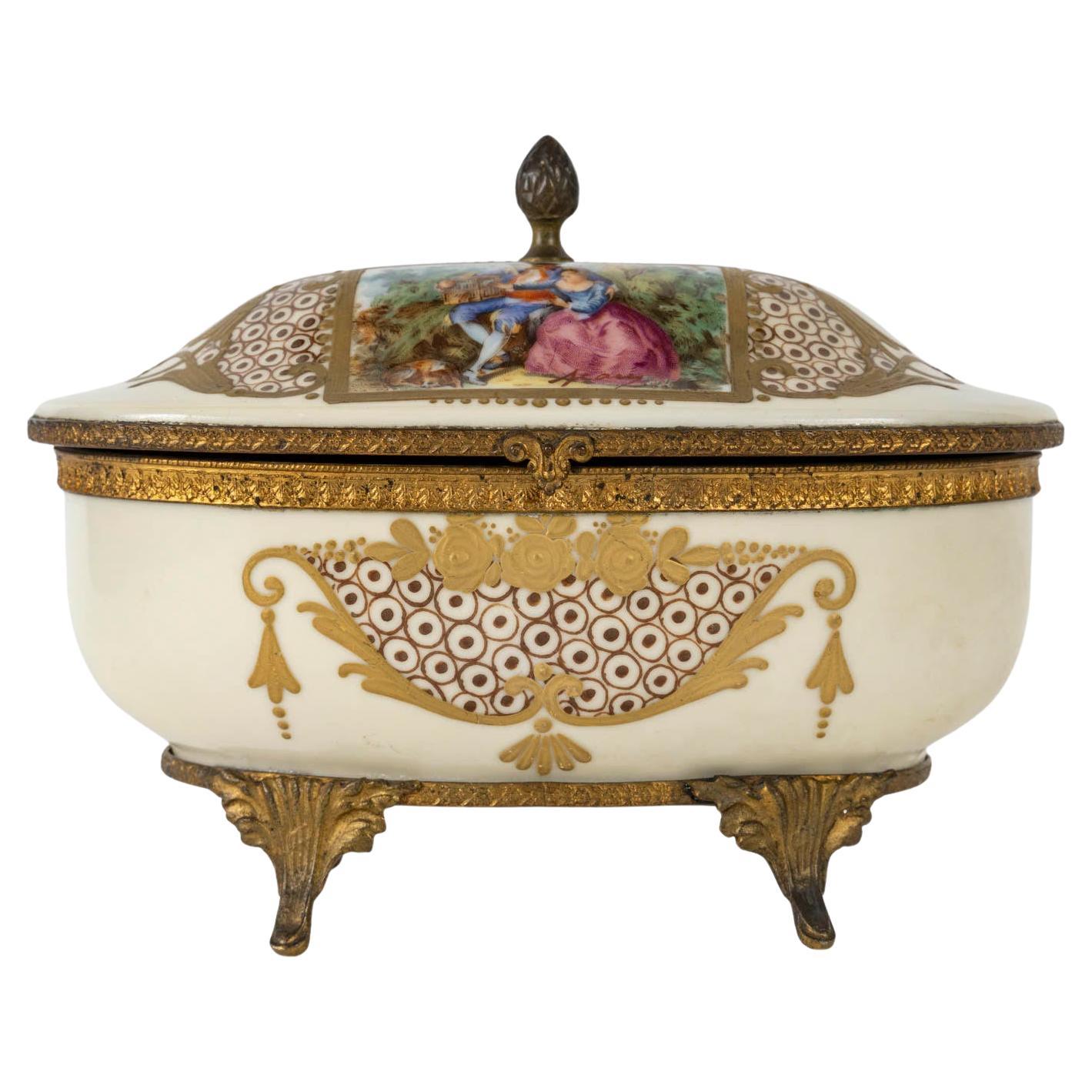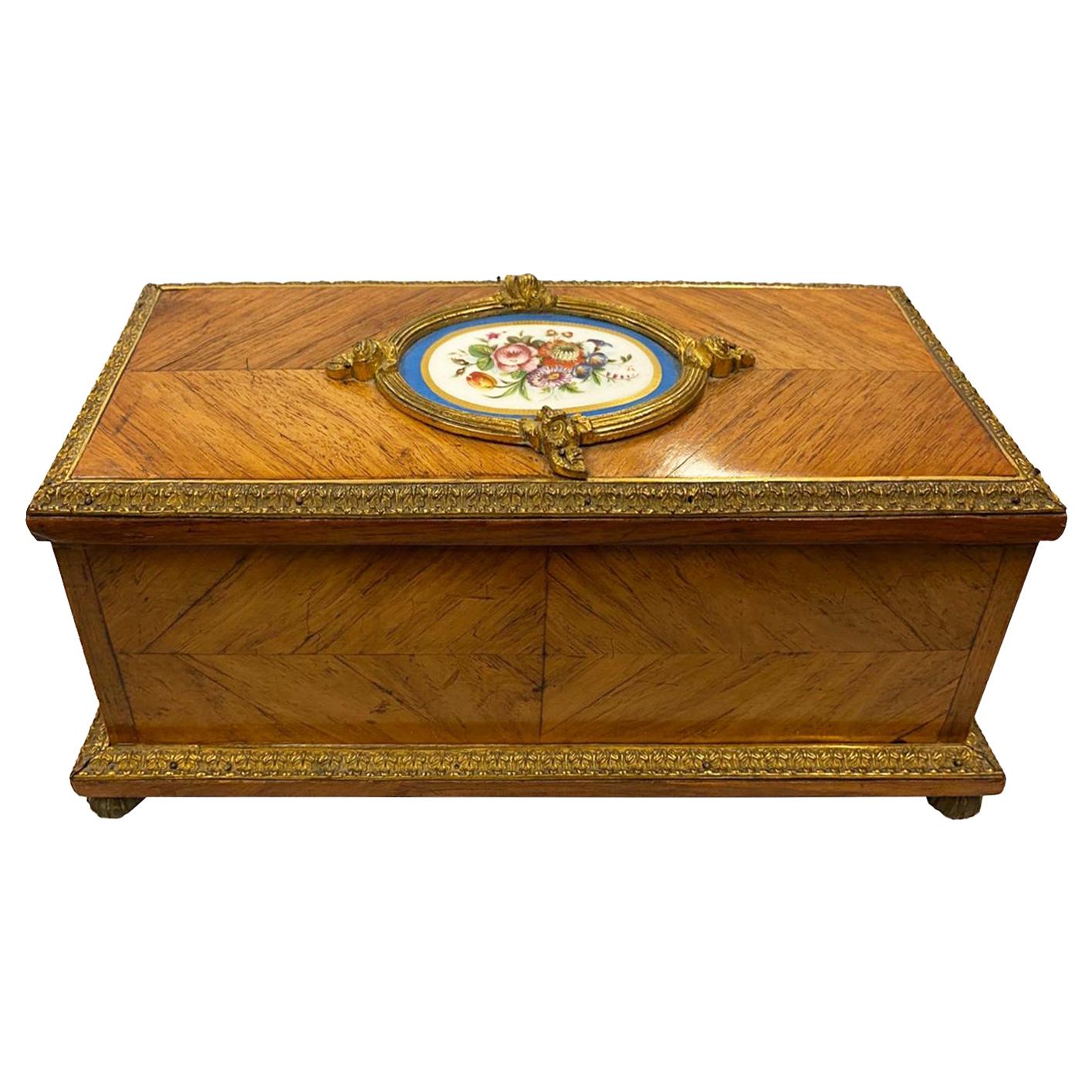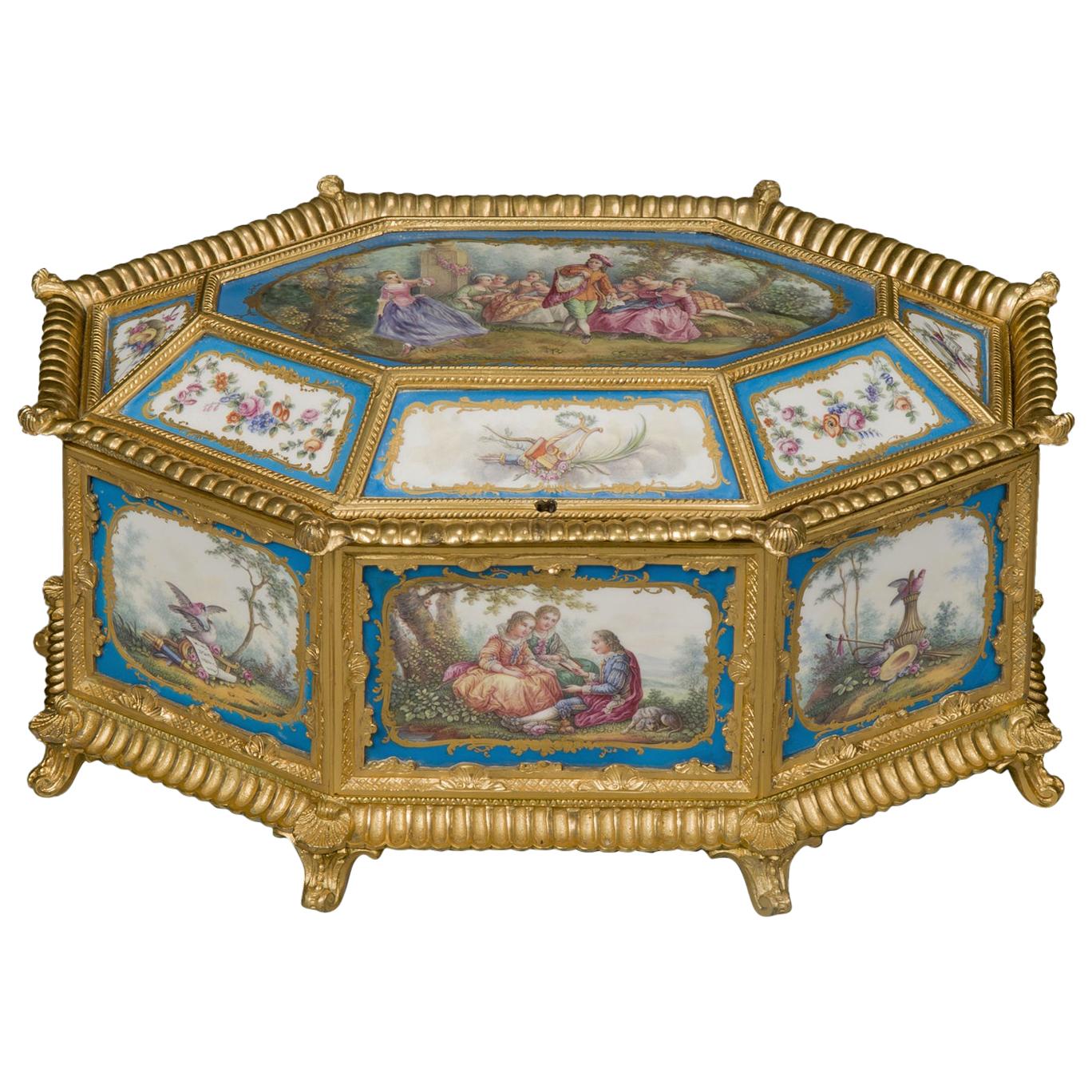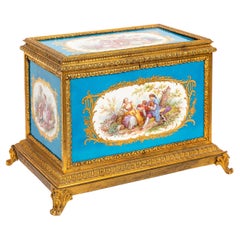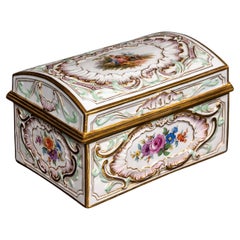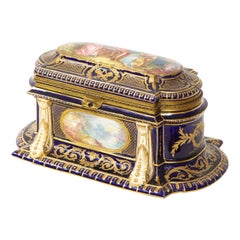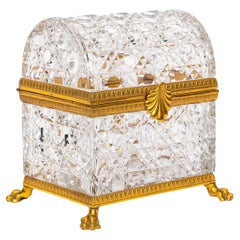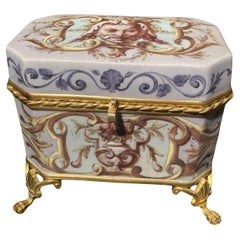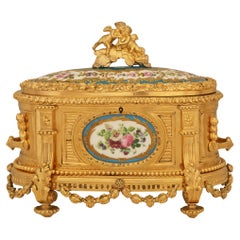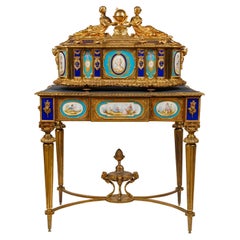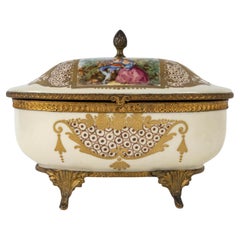Items Similar to Important Empire Period Paris Porcelain & Ormolu-Mounted Casket/Box/Jewelry Box
Want more images or videos?
Request additional images or videos from the seller
1 of 11
Important Empire Period Paris Porcelain & Ormolu-Mounted Casket/Box/Jewelry Box
Price Upon Request
Price Upon Request
Price Upon Request
Price Upon Request
Price Upon Request
Price Upon Request
Price Upon Request
Price Upon Request
Price Upon Request
Price Upon Request
Shipping
Retrieving quote...The 1stDibs Promise:
Authenticity Guarantee,
Money-Back Guarantee,
24-Hour Cancellation
About the Item
An Important and very rare Empire period Paris porcelain ormolu-mounted Empire rectangular shaped two-handled casket decorated and assembled by Feuillet or Sèvres Porcelain manufactures. The cover inset with a simulated hard stone cameo of Ceres in profile to the right within a circular ormolu frame, flanked by scrolling green acanthus issuing pink anthemion and blue flower heads, the side-panels with garlands of flowers on a gilt-ground, the casket with an embossed hand chiseled ormolu frame enclosing four flared rectangular pale-lilac-ground panels with similar decoration centered by trophies, mounted with ormolu double-scroll foliage handles cast with a winged lion mask, supported on four paw feet, the interior fitted with original silk lining and chenille trimming,
circa 1815-1820
This Paris porcelain ormolu-mounted casket encapsulates the lavish refinements of the Empire period. It was most probably given to a high-ranking lady as a gift on the occasion of her marriage, or perhaps after the birth of a child. The cover is inset with a Fine simulated hardstone cameo of Ceres, the Greek goddess of agriculture who was emblematic of fertility and plenty, making this casket a fitting and symbolic gift. The casket is closely related to a smaller workbox with similar ormolu mounts and cameo decoration now in the Victoria and Albert Museum, London. The V&A example is inscribed ‘Feuillet Rue de la paix 18’ to the underside of the cover and has a contemporary Feuillet paper label to the underside. Although the present casket is considerably larger in size and finer in quality, its similarity to the V&A workbox suggests that it was assembled by Feuillet.
Jean-Pierre Feuillet (1777-1840) was a leading Parisian decorator and retailer who set up a shop in Paris on the rue de la Paix under the protection of the prince de Condé. Feuillet gained a reputation as one of the best porcelain decorators in the city and he used porcelain blanks from a variety of Parisian manufacturers including Nast and Darte Frères, supplying many aristocratic collectors. The porcelain panels used in the present casket would probably have been supplied as blanks to Feuillet, and subsequently decorated and mounted in ormolu by Feuillet, as is the case with the example in the V&A. The V&A workbox was bequeathed by Mrs. T.R.P. Hole in memory of Bettine, Lady Abingdon, and was once part of a large collection of French Empire decorative arts owned by Charles Stuart, Lord Stuart de Rothesay (1779–1845) who was the British Ambassador in France during the Napoleonic wars. It seems likely that the present casket was also intended for a similarly important collector.
The painting of trompe l’oeil cameos in imitation of hardstone cameos became a popular but technically challenging decorative technique used by many of the leading Continental porcelain factories in the late 18th and early 19th century. The technique was first used at the Sèvres manufactory in the late 18th century, but it was only truly mastered under the directorship of Alexandre Brongniart in the early 19th century. Brongniart’s training as a mineralogist could well have influenced the refinement of the technique at Sèvres. Cameos had a particular appeal to Napoleon, and he ordered vases and services painted with them, including two services called Service ‘Icongraphique’ from Sèvres painted by the artist Degault with figures from antiquity. Cameos were well adapted for Imperial propaganda, lending an antique authenticity but also alluding to the cultured fashion for classicism. Designs for such cameos were taken from Ennino-Quirino Visconti’s, Iconographie grecque, published by order of Napoleon in Paris in 1808. Visconti (1751-1818) was an Italian antiquarian and art historian, papal Prefect of Antiquities, and an expert on ancient Roman sculpture. Copies of his three volume work were given out as gifts and disseminated through Sèvres and other Parisian factories and it seems very likely that the artist who painted the Ceres cameo seen here drew inspiration from Visconti’s publication.
Because of the technical difficulties presented by painting cameos, Feuillet most probably turned to one of the best independent decorators to supply the central cameo panel for this casket. The two most celebrated decorators specialising in this technique were Jean-Marie Degault and Louis-Bertin Parant. Of the two, Parant was the leading artist in cameo decoration; although he was employed by Sèvres to work on important commissions he was not part of the regular workforce, preferring to work independently in his own studio in Paris, decorating both Sèvres and other porcelains. Brongniart was continually frustrated at the slow progress of Parant, who was a perfectionist and had gone to great lengths to find Authentic Models for his cameo portraits. Parant’s slow progress was to benefit other accomplished artists, including Jean-Marie Degault who gained further commissions from Sèvres as a result. It is not known whether Degault worked exclusively for Sèvres, or whether he also worked as an independent decorator, but the pair of Sèvres vases ‘fuseau’ decorated by Degault and now in the Twinight Collection, New York, show a similar subtle depth of detail to each of the Emperor’s laurel crowns and the style of the calligraphy of the inscription is also close to that seen on the cameo on the present casket.
- Creator:Jean-Pierre Feuillet (Maker)
- Dimensions:Height: 6.75 in (17.15 cm)Width: 15.75 in (40.01 cm)Depth: 10.5 in (26.67 cm)
- Style:Empire (Of the Period)
- Materials and Techniques:
- Place of Origin:
- Period:
- Date of Manufacture:1815
- Condition:Wear consistent with age and use.
- Seller Location:New York, NY
- Reference Number:1stDibs: f919518070211269241fs
About the Seller
4.9
Platinum Seller
Premium sellers with a 4.7+ rating and 24-hour response times
Established in 1820
1stDibs seller since 2011
191 sales on 1stDibs
Typical response time: <1 hour
- ShippingRetrieving quote...Shipping from: New York, NY
- Return Policy
Authenticity Guarantee
In the unlikely event there’s an issue with an item’s authenticity, contact us within 1 year for a full refund. DetailsMoney-Back Guarantee
If your item is not as described, is damaged in transit, or does not arrive, contact us within 7 days for a full refund. Details24-Hour Cancellation
You have a 24-hour grace period in which to reconsider your purchase, with no questions asked.Vetted Professional Sellers
Our world-class sellers must adhere to strict standards for service and quality, maintaining the integrity of our listings.Price-Match Guarantee
If you find that a seller listed the same item for a lower price elsewhere, we’ll match it.Trusted Global Delivery
Our best-in-class carrier network provides specialized shipping options worldwide, including custom delivery.More From This Seller
View AllVery Large 19th Century Ormolu Mounted Sèvres Celeste Blue Ground Porcelain Box
Located in New York, NY
A Very Large 19th Century Ormolu Mounted Sèvres Celeste Blue Ground Porcelain Box with Watteau Scene Cartouches. This box consists of signature celeste blue ground of Sèvres porcela...
Category
Antique 1870s French Louis XVI Decorative Boxes
Materials
Ormolu
A 19th Century Meissen Porcelain Ormolu Mounted Hinged Box with Watteau Scene
By Meissen Porcelain
Located in New York, NY
A 19th Century Meissen Porcelain Ormolu Mounted Hinged Box with Watteau Scene Cartouche and the Interior Decorated with Floral Designs.
The box features an ormolu-mounted structure w...
Category
Antique 1860s German Rococo Decorative Boxes
Materials
Bronze
Very Rare 19th C. Cobalt Blue Ground Sevres Porcelain Jewelry Box
By Manufacture Nationale de Sèvres
Located in New York, NY
A very large and unusual 19th century French Louis XVI style dore bronze mounted Sevres cobalt blue ground box signed Sarat. This box is truly a masterpiece. Sevres boxes...
Category
Antique 1860s French Louis XVI Decorative Boxes
Materials
Bronze
$20,800 Sale Price
20% Off
A Large 19th C French Ormolu Mounted Footed Prismatic Crystal Box, Domed top
By Baccarat
Located in New York, NY
A Beautiful and Quite Large 19th Century French Ormolu Mounted Footed Crystal Box. The top crystal is domed and sits on a hinged ormolu mount with a seashell clasp. The crystal is ...
Category
Antique 1890s French Louis XVI Decorative Boxes
Materials
Crystal, Ormolu
Sevres Porcelain Cobalt Blue Ground Watteau Lovers Scene Bombay form Box, Signed
By Manufacture Nationale de Sèvres
Located in New York, NY
A fabulous French Louis XVI style Sevres Porcelain cobalt blue Ground Watteau Lovers Scene Bombay form jewel box and cover, Signed by the Artist. Of cartouche form with bombay shaped...
Category
Antique 1880s French Louis XVI Jewelry Boxes
Materials
Porcelain
Large & Important French 19th C. Sevres Porcelain Ormolu Mounted Jardiniere
By Manufacture Nationale de Sèvres
Located in New York, NY
A Large & Important French 19th C. Louis XVI Style Sevres Porcelain Ormolu Mounted Jardiniere. This magnificent piece is of a baluster form wi...
Category
Antique 1870s French Louis XVI Planters, Cachepots and Jardinières
Materials
Bronze
You May Also Like
French 19th Century Empire Porcelain and Gilt Bronze Decorative Jewelry Box
Located in Firenze, IT
This French Empire 19th century rectangular porcelain dresser box or jewlery decorative casket has a wonderfully patinated powder blue/cerulean light blue background color and features grotesque masks, architectural vase, fruit, flowers and leafy scrolled design throughout painted as a trompe l’oeil in the round. Ormolu mounts enrich the whole box.
The paintings on this casket are striking as is the color palette used, a wonderful mix of light purple, cream, blue and soft brown.
The lid is centered by a grotesque mask inspired by antiquity. The front, back and sides are profusely decorated with architectural elements, cartouches and volutes. The design is centered by a vase with a fruit arrangement that appear to be plums. The decoration could refer to the allegory of autumn and the mask painted on the lid could refer to Bacchus.
Both the color of the porcelain and the paintings are very unusual and a sign of high quality and uniqueness.The box was most probably given to a high-ranking lady as a gift on the occasion of her marriage, or perhaps after the birth of a child.
The lidded box is fitted with ormolu mounts, hinges and clasp. A gilt bronze band finelly chiseled in the form of a rope adorns the upper part. The trinket box rests on four gilt bronze lion paw feet.
This striking French porcelain box...
Category
Antique 19th Century French Empire Jewelry Boxes
Materials
Bronze, Ormolu
French 19th century Louis XVI st. Ormolu and Sévres Porcelain box.
Located in West Palm Beach, FL
An elegant and elaborately decorated French 19th century Louis XVI st. Ormolu and Sévres Porcelain box. This charming oblong oval shaped lidded box is raised by four toupie shaped fe...
Category
Antique 19th Century French Louis XVI Decorative Boxes
Materials
Ormolu
Important, Rare French Ormolu Sevres Style Porcelain Jewelry Box on Bronze Table
Located in Queens, NY
A rare and important French ormolu/bronze and Sevres style turquoise porcelain jewelry box casket on matching French ormolu/bronze table with Sevres style porcelain plaques.
Of palatial / monumental size!
"The Marie Antoinette Jewelry...
Category
Antique Late 19th Century French Napoleon III Jewelry Boxes
Materials
Bronze, Enamel, Ormolu
Sèvres Porcelain Box, Enamelled and Gilded, 20th Century, Napoleon III Style.
Located in Saint-Ouen, FR
Sèvres porcelain box, enamelled and gilded, 20th century, Napoleon III style.
A 20th century Napoleon III style Sèvres porcelain enamelled and gilt box with gilt brass mounting.
H: ...
Category
20th Century French Napoleon III Decorative Boxes
Materials
Porcelain
French 19th Century 'Sevres' Porcelain Mounted Casket
By Tahan Paris
Located in Brighton, Sussex
A fine quality late 19th century gilded ormolu and Sevres style porcelain mounted casket, the hinged lid opening to a silk lined interior (needing repair) and raised on ormolu melon ...
Category
Antique Late 19th Century French Louis XVI Decorative Boxes
Materials
Porcelain, Walnut
Louis XVI Style Sèvres-Style Porcelain Mounted Octagonal Table Box, circa 1890
By Manufacture Nationale de Sèvres
Located in Brighton, West Sussex
A fine Louis XVI style gilt bronze and Sèvres-style porcelain mounted octagonal table box.
French, circa 1890.
This fine porcelain and gilt bronze-mounted box has an octagonal ...
Category
Antique Late 19th Century French Louis XVI Decorative Boxes
Materials
Bronze
More Ways To Browse
Antique Gold Box
Green Jewelry Box
Pink Box
Call Box
Jewellery Box Pink
18th Century Gold Box
Large Stone Box
Antique Blue Boxes
Antique Flower Box
Antique Collectors Box
Porcelain Ormolu Mounted
Antique Gilt Box
Antique Artist Box
Antique Jewellery Boxes London
Bronze Box Large
Lion Box
British Empire Furniture
L Paris Jewelry
